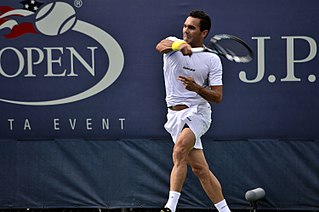Related Research Articles

Ramón Delgado is a Paraguayan retired tennis player and current tennis coach. He turned professional in 1995 and achieved a career-high singles ranking of world No. 52 in April 1999. He reached the final at Bogotá in 1998 and the fourth round of the 1998 French Open, defeating Pete Sampras in the second round.
Tomáš Šmíd is a former tennis player from Czechoslovakia, who won nine singles titles during his career. In doubles, he won 54 titles and was world No. 1 in doubles from December 17, 1984 to August 11, 1985. The right-hander reached his highest ATP singles ranking of world No. 11 in July 1984. Šmíd participated in 31 Davis Cup ties for Czechoslovakia from 1977–1989, posting a 20-10 record in doubles and a 22-15 record in singles. Šmíd was a part of the winning 1980 Davis Cup team, a team which included Ivan Lendl. In the final against Italy, Šmíd won a singles rubber against Adriano Panatta after being two sets down, and won the doubles rubber when partnered with Lendl as they beat Panatta and Paolo Bertolucci to clinch the 1980 Davis Cup for Czechoslovakia.

The France men's national tennis team represents France in Davis Cup tennis competition, and is governed by the Fédération Française de Tennis. France competed in their first Davis Cup in 1904.
France is the third most successful nation, with ten wins. Their most recent title came in 2017 .
The Germany Davis Cup team represents Germany in Davis Cup tennis competition and are governed by the Deutscher Tennis Bund. As East Germany never participated in the Davis Cup, and the Deutscher Tennisbund remained the same organization throughout the century, the West German Davis Cup team is included in this article.
The 1931 International Lawn Tennis Challenge was the 26th edition of what is now known as the Davis Cup.
The 1935 International Lawn Tennis Challenge was the 30th edition of what is now known as the Davis Cup. Due to increased political tensions in Europe, entries for the Europe Zone declined sharply, causing the qualifying round system to be scrapped. Only 11 teams would enter the Europe Zone, with 17 teams entering the qualifying rounds; while six would enter the Americas Zone, 4 in North America and 2 in South America. Estonia entered the tournament for the first time.
The 1947 Davis Cup was the 36th edition of the most important tournament between national teams in men's tennis. 20 teams entered the Europe Zone, and 2 teams entered the America Zone. Luxembourg competed for the first time.
The 1948 Davis Cup was the 37th edition of the most important tournament between national teams in men's tennis. 25 teams entered the Europe Zone, and four teams entered the America Zone. Pakistan and Turkey made their first appearances in the competition.
The 1971 Davis Cup was the 60th edition of the Davis Cup, the most important tournament between national teams in men's tennis. 28 teams entered the Europe Zone, 13 teams entered the Americas Zone, and 9 teams entered the Eastern Zone. Bolivia made its first appearance in the tournament.
The 1972 Davis Cup was the 61st edition of the Davis Cup, the most important tournament between national teams in men's tennis. 55 teams would enter the competition, 33 in the Europe Zone, 11 in the Americas Zone, and 11 in the Eastern Zone.
The 1992 Davis Cup was the 81st edition of the Davis Cup, the most important tournament between national teams in men's tennis. 93 teams would enter the competition, 16 in the World Group, 21 in the Americas Zone, 23 in the Asia/Oceania Zone, and 33 in the Europe/Africa Zone. Due to the increased number of entries, the tournament was expanded to add a Group III in all zones, with promotion and relegation between it and Group II. Puerto Rico and Qatar made their first appearances in the tournament, and former champions South Africa returned to the tournament for the first time since 1978.

Víctor Estrella Burgos is a retired Dominican professional tennis player. In 2014, Estrella became the first Dominican to reach the top 100 in the ATP rankings. He also became the first Dominican player to reach the semifinals in an ATP 250 tournament in Bogota. In 2015, he also became the first tennis player from his country to participate in all four Grand Slams, playing in the Australian Open. In February 2015, he won his first career ATP title at the Ecuador Open, becoming the oldest first-time ATP tour winner in the Open Era. He successfully defended his title with a 100% winning record at the event in 2016 and 2017, but lost in the second round in 2018.
The World Group was the highest level of Davis Cup competition in 1983.
The World Group was the highest level of Davis Cup competition in 1984.
The World Group was the highest level of Davis Cup competition in 1985.
The World Group was the highest level of Davis Cup competition in 1986.
The World Group was the highest level of Davis Cup competition in 1987.
The World Group was the highest level of Davis Cup competition in 1988.
The World Group was the highest level of Davis Cup competition in 1989. The first-round losers went into the Davis Cup World Group qualifying round, and the winners progressed to the quarterfinals and were guaranteed a World Group spot for 1990.
The World Group was the highest level of Davis Cup competition in 1991. The first-round losers went into the Davis Cup World Group qualifying round, and the winners progressed to the quarterfinals and were guaranteed a World Group spot for 1992.
References
- ↑ "Paraguay v Czechoslovakia". daviscup.com.
- sports-reference
- Victor Caballero at the Association of Tennis Professionals
- Victor Caballero at the International Tennis Federation
- Victor Caballero at the Davis Cup